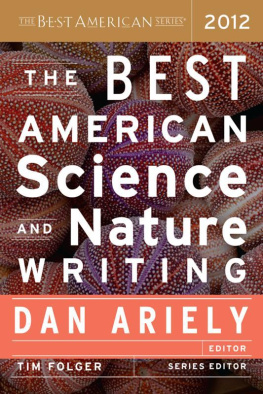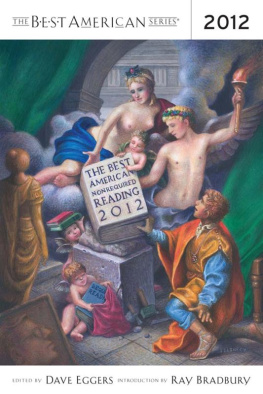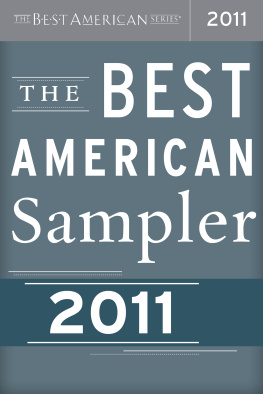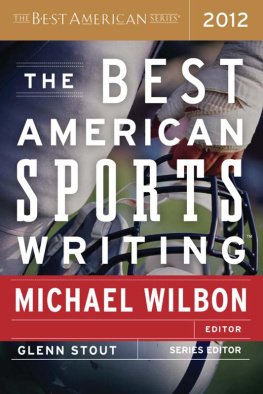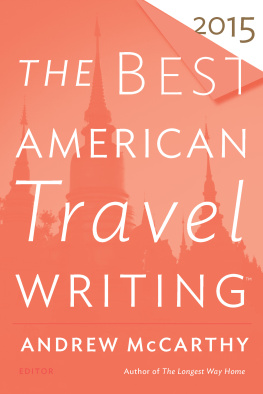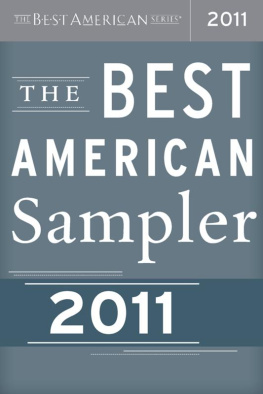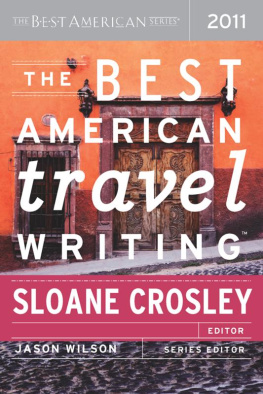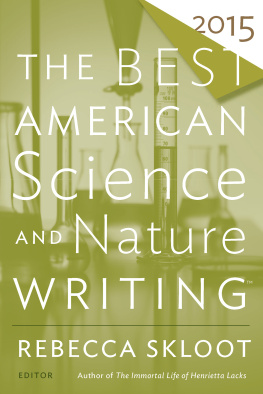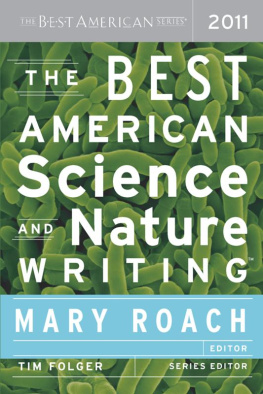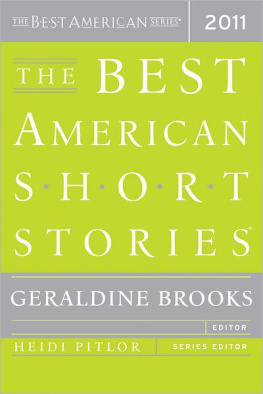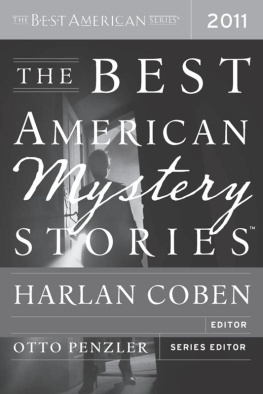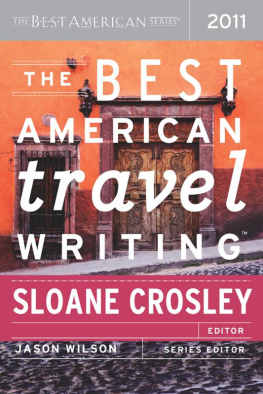
Table of Contents
Copyright 2012 by Houghton Mifflin Harcourt Publishing Company
Introduction copyright 2012 by Dan Ariely
ALL RIGHTS RESERVED
The Best American Science and Nature Writing is a trademark of Houghton Mifflin Harcourt Publishing Company. The Best American Series is a registered trademark of Houghton Mifflin Harcourt Publishing Company.
No part of this work may be reproduced or transmitted in any form or by any means, electronic or mechanical, including photocopying and recording, or by any information storage or retrieval system without the prior written permission of the copyright owner unless such copying is expressly permitted by federal copyright law. With the exception of nonprofit transcription in Braille, Houghton Mifflin Harcourt is not authorized to grant permission for further uses of copyrighted selections reprinted in this book without the permission of their owners. Permission must be obtained from the individual copyright owners identified herein. Address requests for permission to make copies of Houghton Mifflin Harcourt material to Permissions, Houghton Mifflin Harcourt Publishing Company, 215 Park Avenue South, New York, New York 10003.
www.hmhbooks.com
ISSN 1530-1508
ISBN 978-0-547-79953-7
e ISBN 978-0-547-79954-4
v1.1012
Faster. Higher. Squeakier. by Michael Behar. First published in Outside, February 2011. Copyright 2011 by Michael Behar. Reprinted by permission of Michael Behar.
The Scent of Your Thoughts by Deborah Blum. First published in Scientific American, October 2011. Copyright 2011 by Deborah Blum. Reprinted by permission of Scientific American.
The Teeming Metropolis of You by Brendan Buhler. First published in California MagazineUC Berkeley Alumni, Fall 2011. Copyright 2011 by Brendan Buhler. Reprinted by permission of the author.
Mind vs. Machine by Brian Christian. First published in The Atlantic, March 2011. Copyright 2011 by Brian Christian. Reprinted by permission of The Atlantic.
What You Dont Know Can Kill You by Jason Daley. First published in Discover, July/August 2011. Copyright 2012 by Jason Daley. Reprinted by permission of Jason Daley.
The Crypto-Currency by Joshua Davis. First published in The New Yorker, October 10, 2011. Copyright 2011 by Joshua Davis. Reprinted by permission of Joshua Davis.
Beautiful Brains by David Dobbs. First published in National Geographic, October 2011. Copyright 2011 by David Dobbs. Reprinted by permission of David Dobbs.
The Brain on Trial by David Eagleman. First published in The Atlantic, July/August 2011. Copyright 2011 by David Eagleman. Reprinted by permission of the author.
Dream Machine by Rivka Galchen. First published in The New Yorker, May 2, 2011. Copyright 2011 by Rivka Galchen. Reprinted by permission of Rivka Galchen.
The Feedback Loop by Thomas Goetz. First published in Wired, July 2011. Copyright 2011 Cond Nast. All rights reserved. Reprinted by permission.
The Peanut Puzzle by Jerome Groopman. First published in The New Yorker, February 7, 2011. Copyright 2011 by Jerome Groopman. Reprinted by permission of Jerome Groopman.
How to Hatch a Dinosaur by Thomas Hayden. First published in Wired, October 2011. Copyright 2011 Cond Nast. All rights reserved. Reprinted by permission.
Our Body the Ecosystem by Virginia Hughes. First published in Popular Science, March 2011. Copyright 2011 by Popular Science. Reprinted by permission of Bonnier Corporation.
Ill Wind by David Kirby. First published in Discover, April 2011. Copyright 2011 by David Kirby. Reprinted by permission of David Kirby.
Sleeping with the Enemy by Elizabeth Kolbert. First published in The New Yorker, August 15 & 22, 2011. Copyright 2011 by Elizabeth Kolbert. Reprinted by permission of Elizabeth Kolbert.
The City Solution by Robert Kunzig. First published in National Geographic, December 2011. Copyright 2011 by National Geographic Society. Reprinted by permission.
Mad Science by Mark McClusky. First published in Wired, March 2011. Copyright 2011 Cond Nast. All rights reserved. Reprinted by permission.
Ants & the Art of War by Mark Moffett. First published in Scientific American, December 2011. Used with permission. Copyright 2011 by Scientific American, a division of Nature America, Inc. All rights reserved.
Deep Intellect by Sy Montgomery. First published in Orion, November/December 2011. Copyright 2011 by Sy Montgomery. Reprinted by permission of Sy Montgomery.
The Touchy-Feely (but Totally Scientific!) Methods of Wallace J. Nichols by Michael Roberts. First published in Outside, December 2011. Copyright 2011 by Michael Roberts. Reprinted by permission of Michael Roberts.
Crush Point by John Seabrook. First published in The New Yorker, February 7, 2011. Copyright 2011 by John Seabrook. Reprinted by permission of John Seabrook.
Test-Tube Burgers by Michael Specter. First published in The New Yorker, May 23, 2011. Copyright 2011 by Michael Specter. Reprinted by permission of Michael Specter.
The Wipeout Gene by Bijal Trivedi. First published in Scientific American, November 2011. Copyright 2011 by Scientific American, a Division of Nature America, Inc. All rights reserved. Reprinted by permission of Bijal Trivedi.
The Long, Curious, Extravagant Evolution of Feathers by Carl Zimmer. First published in National Geographic, February 2011. Copyright 2011 by Carl Zimmer. Reprinted by permission of Carl Zimmer.
Foreword
L AST NOVEMBER, WHILE gathering articles for this collection, I read that Lynn Margulis had died. She was one of the great evolutionary biologists of our time, and exceedingly controversial. In 1967, when she was twenty-nine, she published a paper that transformed our understanding of the evolution of life. Before being accepted by the Journal of Theoretical Biology, the manuscript had been rejected by fifteen other journalsthe academic equivalent of publishing houses turning down the first Harry Potter book. Her forty-nine-page article challenged one of the bedrock principles of modern biology: that random mutation was the prime driver of evolution. Margulis argued instead that some of the most crucial evolutionary developments in the 3.8-billion-year history of life on Earth were the result of cooperative and mutually beneficial relationships among organisms. Specifically, she was convinced that more complex forms of life arose when simpler ones merged into a single organismto the advantage of all parties involved. She called the process symbiogenesis.
Margulis looked to the humblest living things to find evidence for her hypothesis. She argued that in the distant past, primitive single-celled creatures combined, creating more elaborate cells that would eventually give rise to all higher forms of life. The traces of those ancient unions remain today in nearly every cell of our bodies. It is now generally accepted that mitochondriamicroscopic components of our cells that provide the chemical energy that keeps us aliveonce existed as free-living bacteria that were engulfed by some larger cell, an event that probably happened roughly 2 billion years ago. Chloroplasts, the tiny engines of photosynthesis found in all plant cells, had similar origins. Without symbiogenesis, there would be no flowers, no trees, no grass, no animals, insects, or people. There would be no oxygen in the atmosphere.
Next page
